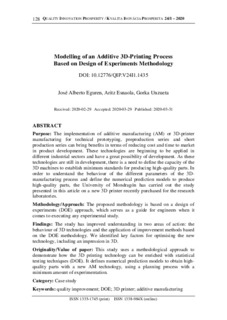| dc.rights.license | Attribution 4.0 International | * |
| dc.contributor.author | Eguren, Jose Alberto | |
| dc.contributor.author | Esnaola, Aritz | |
| dc.contributor.author | Unzueta, Gorka | |
| dc.date.accessioned | 2020-05-29T07:37:43Z | |
| dc.date.available | 2020-05-29T07:37:43Z | |
| dc.date.issued | 2020 | |
| dc.identifier.issn | 1338-984X | en |
| dc.identifier.other | https://katalogoa.mondragon.edu/janium-bin/janium_login_opac.pl?find&ficha_no=158251 | en |
| dc.identifier.uri | https://hdl.handle.net/20.500.11984/1672 | |
| dc.description.abstract | Purpose: The implementation of additive manufacturing (AM) or 3D-printer manufacturing for technical prototyping, preproduction series and short production series can bring benefits in terms of reducing cost and time to market in product development. These technologies are beginning to be applied in different industrial sectors and have a great possibility of development. As these technologies are still in development, there is a need to define the capacity of the 3D machines to establish minimum standards for producing high-quality parts.
Methodology/Approach: The proposed methodology is based on a design of experiments (DOE) approach, which serves as a guide for engineers when it comes to executing any experimental study. The following steps were followed (Unzueta et al., 2019): Phase 1: define; Phase 2: measure; Phase 3: plan; Phase 4: execute experimentation; Phase 5: analyse the results; Phase 6: improve via confirmation experiments; Phases 7-8: control and standardise.
Findings: The proposed methodology is based on a design of experiments (DOE) approach, which serves as a guide for engineers when it comes to executing any experimental study. The following steps were followed (Unzueta et al., 2019): Phase 1: define; Phase 2: measure; Phase 3: plan; Phase 4: execute experimentation; Phase 5: analyse the results; Phase 6: improve via confirmation experiments; Phases 7-8: control and standardise.
Originality/Value of paper: This study uses a methodological approach to demonstrate how the 3D printing technology can be enriched with statistical testing techniques (DOE). It defines numerical prediction models to obtain high-quality parts with a new AM technology, using a planning process with a minimum amount of experimentation. | en |
| dc.language.iso | eng | en |
| dc.publisher | Technical University of Kosice, Slovakia | en |
| dc.rights | © 2020 Jose Alberto Eguren, Aritz Esnaola, Gorka Unzueta | en |
| dc.rights.uri | http://creativecommons.org/licenses/by/4.0/ | * |
| dc.subject | quality improvement | en |
| dc.subject | DOE | en |
| dc.subject | 3D printer | en |
| dc.subject | additive manufacturing | en |
| dc.title | Modelling of an Additive 3D-Printing Process Based on Design of Experiments Methodology | en |
| dcterms.accessRights | http://purl.org/coar/access_right/c_abf2 | en |
| dcterms.source | Quality, Innovation, Prosperity | en |
| local.contributor.group | Dirección de operaciones logístico productivas | es |
| local.description.peerreviewed | true | en |
| local.identifier.doi | http://dx.doi.org/10.12776/qip.v24i1.1435 | en |
| local.source.details | Vol. 24. N. 1, 2020 | eu_ES |
| oaire.format.mimetype | application/pdf | |
| oaire.file | $DSPACE\assetstore | |
| oaire.resourceType | http://purl.org/coar/resource_type/c_6501 | en |
| oaire.version | http://purl.org/coar/version/c_970fb48d4fbd8a85 | en |








